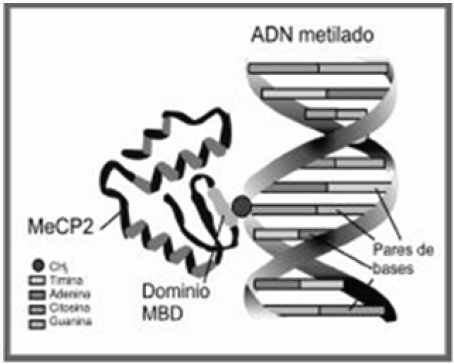
Lupine Publishers Group
Lupine Publishers
Menu
ISSN: 2637-6628
Case Report(ISSN: 2637-6628) 
Rett Syndrome Volume 1 - Issue 4
Rodriguez Rivera Sofia Lucila*
- Department of Pediatric Neurology, Centro Medico Nacional La Raza, USA
Received: Jun 05, 2018; Published: June 11, 2018
Corresponding author: Rodriguez Rivera Sofia Lucila, Department of Pediatric Neurology, Centro Medico Nacional La Raza, Mexico, Codigo Postal: 02990, USA
DOI: 10.32474/OJNBD.2018.01.000116
Abstract
Rett sindrome is a severe neuro developmental disorder that is a leading cause of mental retardation in females, characterized by an apparently normal psycho motor development through the first 6 months of life, followed by stagnation and growth regression in different are as like motor, language and social skills; patients often exhibitautistic behaviors in the early stages. Other symptoms include seizures, breathing problems when awake such as hyper ventilation, apnea, and swallowing air; ataxia and stereotypich and movements. It is caused by mutations in the X-linked gene encodingmethyl-CpG-binding protein 2 (MECP2) [1,2]. One case is presented with positive molecular study.
Keywords: Autism; Intellectual Disability; Rett Syndrome
Introduction
Rett síndrome was first described in 1966 by the austrian neurologist Andreas Rett. It usually affects women and is the second cause of profound mental retardation. Its cause has been associated with a mutation located on the X chromosome in Xq28 in the MECP2 gene that codes for the proteinmethyl-CpG-binding protein [3,4].
Case Report
Female 2 years old without significant family or perinatal history. At 6 months old, she presented neurodevelopment regression, not achieving a sitting position and losing the cephalic support with epileptic spasms in flexion, 10 times a day, with 7clusters, in wakefulness. At the current physical examination with head circumference 16 in, with little visual contact, there are stereotypies in the hands, spasticity, screaming battacks, no language, there is only babbling, with episodes of hyperventilation and sleep disturbance. MRI of the skull with ventriculomegaly. Electro encephalogram hypsar rhythmia with burst supression. Molecular study positive for MECP2 in exon 4c.1233C>T. Current treatment with vigabatr in and magnesium valproate [5].
Discussion
In 2004, Kammoun et al. [6] Proposed four basic criteria for diagnosis:
a) severe psychomotor delay, with impairment of receptor and expressive language.
b) cephalic perimeter inferior to normal.
c) Loss of useful employment of the hand, associated with a dysfunction in communication and social isolation.
d) Appearance of stereotyped movements of the hands. Other characteristic symptoms are walking on tiptoe, sleeping problems, bruxism, seizures, apnea and / or hyperventilation [5,6].
Conclusion
The case present edisstage 2, late destructive, with loss of acquired skills, global neurodevelopmental delay, respiratory alterations and epileptic seizures. There is no specific treatment that can reverse or stop the course of the disease. The rapeutic management revolves around the restoration of synaptic function and maturation, since it has been shown that the deficitis at the level of micro circuits that involve synaptic transmission. The management is symptomatic and individualized. A multidisciplinary and dynamic approach is essential. The knowledge of the genetic causes allows a diagnostic confirmation, a family genetic counseling, an evolutionary prognosis and the application of a therapy to the disease in the very near future [7,8] (Figure 1).
References
- Gharesouran J, Khalili AF, Azari NS, Vahedi L (2015) First case report of Rett síndrome in the Azeri Turkish population and brief review of the literature. Epilepsy & behavior case reports 3: 15-19.
- Williamson Sarah L, Chirstodoulou John (2006) Rettsyndrome: new clinical and molecular insights. European Journal of Human Genetics 14(8): 896-903.
- Lotan Meir (2007) Alternative therapeutic intervention for individuals with Rett syndrome. The Scientific World Journal 7: 698-714.
- Luna Barrón B, Zuleta B, Liders J, Taboada López G, et al. (2014) Diagnóstico clínico y molecular de síndrome de Rett. A propósito de un caso. Revista de la Sociedad Boliviana de Pediatría 53(1): 8-11.
- Cianfaglione R, Clarke A, Kerr M, Hastings RP, Oliver C, et al. (2015) A national survey of Rettsyndrome: behavioural characteristics. Journal of neurodevelopmental Disorders 7(1): 11.
- Kammoun F, De Roux N, Boespflug Tanguy O, et al. (2004) Screening of MECP2 coding sequence in patients with phenotypes of decreasing likelihood for Rettsyndrome: a cohort of 171 cases. Journal of medical genetics 41(6): e85.
- Neul JL, Kaufmann WE, Glaze DG, ChristodoulouJ, Clarke AJ, et al. (2010) Rettsyndrome: revised diagnostic criteria and nomen clature. Annals of Neurology 68(6): 944-950.
- Fernández Lozano M, Puente Ferreras A, Barahona Gomariz M, Palafox Bogdanovitch A (2010) Rasgos conductuales y cognitivos de los síndromes rett, CRI-DU-CHAT, X-FRÁGIL y WILLIAMS. Liberabit 16(1): 39-50.

Top Editors
-

Mark E Smith
Bio chemistry
University of Texas Medical Branch, USA -

Lawrence A Presley
Department of Criminal Justice
Liberty University, USA -

Thomas W Miller
Department of Psychiatry
University of Kentucky, USA -

Gjumrakch Aliev
Department of Medicine
Gally International Biomedical Research & Consulting LLC, USA -

Christopher Bryant
Department of Urbanisation and Agricultural
Montreal university, USA -

Robert William Frare
Oral & Maxillofacial Pathology
New York University, USA -

Rudolph Modesto Navari
Gastroenterology and Hepatology
University of Alabama, UK -

Andrew Hague
Department of Medicine
Universities of Bradford, UK -

George Gregory Buttigieg
Maltese College of Obstetrics and Gynaecology, Europe -

Chen-Hsiung Yeh
Oncology
Circulogene Theranostics, England -
.png)
Emilio Bucio-Carrillo
Radiation Chemistry
National University of Mexico, USA -
.jpg)
Casey J Grenier
Analytical Chemistry
Wentworth Institute of Technology, USA -
Hany Atalah
Minimally Invasive Surgery
Mercer University school of Medicine, USA -

Abu-Hussein Muhamad
Pediatric Dentistry
University of Athens , Greece

The annual scholar awards from Lupine Publishers honor a selected number Read More...















